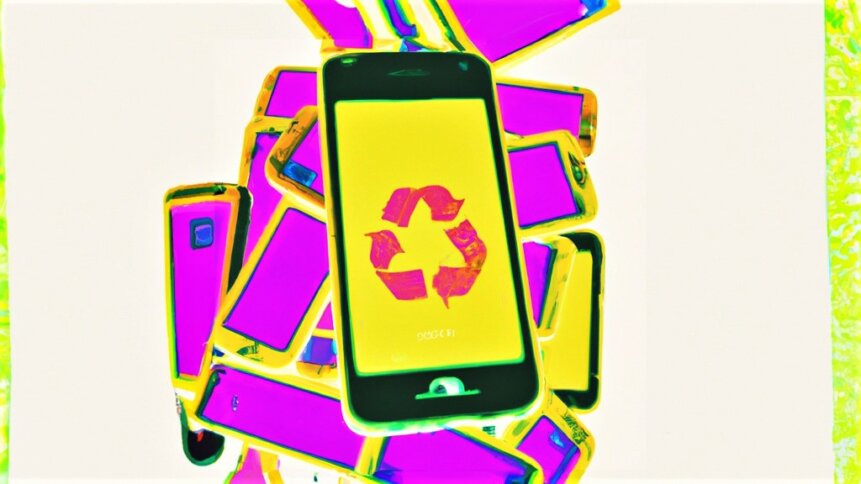Reuse and recycle: R2V3 strengthens circular smartphone economy

|
Getting your Trinity Audio player ready...
|
In investment circles, the theory of efficient markets says that stock prices reflect all information that’s available to traders. And this hypothesis relates to makers of electronic devices just as it applies to any asset. But sparks of the circular smartphone economy point to a golden opportunity that’s still being overlooked by many industry players.
Buried treasure
Low rates of e-waste collection and recycling mean that billions of dollars’ worth of high-value, recoverable materials, including gold and other precious metals, are being thrown away each year. It’s well reported that embedded in 1 million cell phones are 24 kg of gold, 16,000 kg of copper, 350 kg of silver, and 14 kg of palladium. Plus, the concentration of those materials is hundreds of times higher than in the original ores.
And while dipping waste electronics into an innovative chemical soup (a process that The Royal Mint, in partnership with Excir, has shown can retrieve gold in seconds) has its merits – repair and reuse are more profitable, especially for the planet.
Much of the environmental burden associated with electronic goods occurs during manufacturing, and the longer that products can be kept in service, the fewer new items that need to be made. Trailblazers paving the way for a truly circular smartphone economy include Fairphone, which is based in The Netherlands and has a presence in Taiwan and China.
10 out of 10 for repairability
In June 2023, the European Commission proposed new rules to make phones and tablets more durable, energy efficient and easier to repair. The legislation emphasizes the need to make electronic devices longer-lasting. And Fairphone shows what’s already possible today on that front – putting mainstream manufacturers to shame and demonstrating the feasibility of a circular smartphone economy.
The firm’s current device, dubbed Fairphone 4, received a top score of 10 out of 10 for repairability from iFixit’s celebrated teardown team. “For years now, Fairphone has been making very repairable smartphones. They always receive top marks on our repairability scale, and in many ways they are a beacon to the rest of the industry – an example of how to create a truly repairable smartphone,” comments Taylor Dixon, a teardown engineer at iFixit.
Software support, particularly security updates, is another consideration. And Ecodesign regulations in the EU mandate operating system support for at least five years after the product has been placed on the market. And again, Fairphone has valuable experience to share. The circular smartphone economy pioneer finally stopped software support for its Fairphone 2 model in March 2023, more than seven years after the launch of the product.
“This is an incredibly bittersweet moment: the Fairphone 2 has far surpassed our initial hopes to offer three to five years of software support, but in an ideal world, we would be able to support our devices indefinitely,” writes Agnès Crepet – Head of Software Longevity & IT at the Dutch firm – in a blog post to users of the device, which was released in 2015. “The Fairphone 2 makes it clear how far we have come, and how far we still have to go.”
Congratulations @clementlevard on your CNRS Bronze Medal! Timely talk on critical metals and circular economy. Thought for the day: 70 kg of raw materials needed for one 120g smartphone!! @cerege @edurable_cerege pic.twitter.com/vsmE3qMO1T
— Danielle Slomberg (@d_slomberg) October 18, 2019
Other mobile phone providers with aspirations to bolster the circular smartphone economy include HMD Global – which was founded in 2016 by former Nokia executives and has a licensing agreement to use the Nokia brand for its mobile phones. The company, which is based in 50 locations around the world, has recently launched Circular – a mobile subscription service with a difference.
Recognizing that subscribers keeping their phones for longer is better for the planet, Circular rewards customers with credits that ramp up in years two and three and can be used to make a donation to one of the environmental and charitable causes it has partnered with. Projects include tree planting and supporting the generation of clean electricity using solar and wind power. But they are the icing on the cake.
The bigger deal about the subscription scheme – and why it adds to the smartphone circular economy – is that, according to HMD Global, Circular devices are always reused when possible. Mobile phones either get a second life with another subscriber, are donated to charity (if more than three years old and still in working order), or are recycled. And before passing on the device, any information is erased, which brings the discussion to data security and standards for reuse and recycling.
Sustainable electronics: R2V3 reuse & recycling standard
July 1, 2023, was notable as it marked the official start date of R2V3 – the latest version of the sustainable electronic reuse and recycling standard, which represents a ‘trust mark’ for firms looking to dispose of IT assets. Data security is one of 10 core requirements, and the update includes detailed process requirements on data sanitization.
R2V3 sets the standard for responsible reuse and recycling practices for the management and processing of used electronics worldwide. And the auditing and certification process is designed to give customers confidence that operators will manage used electronic equipment, including smartphones, responsibly – considering the environment, the health and safety of workers, and that, as mentioned, all data on all devices is secure and effectively destroyed.
It’s clear that foundations for a truly circular smartphone economy are coming together. And providers such as Fairphone deserve praise for their efforts. The company is the first and only smartphone producer to integrate Fairtrade gold into its supply chain. Plus, customers can see the origin of other materials – for example, tungsten ore and various plastics – that go into their devices using an interactive smartphone supply chain map.
At the same time, there’s so much room for improvement. Putting a positive spin on things, it shows that there are huge gains to be made in reducing the environmental burden of smartphones and other popular electronic devices.
On its environment page, Apple writes that, on average, shipping an item by sea rather than by air reduces transportation-related emissions by 95%. And any customers buying its Mac Studio, Studio Display, and AirPods (3rd generation) products will be in possession of ocean-transported devices. But what about the millions of iPhones, iPads, MacBooks, and other top-selling Apple products?









